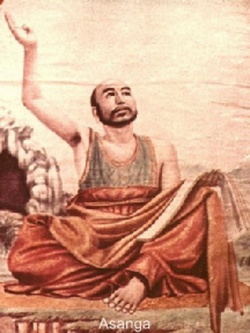Difference between revisions of "The brahmanical tradition"
(Created page with " <poem> It is generally thought that some time after the beginning of the second millennium BCE groups of a nomadic tribal people began to move south from...") |
m (Text replacement - "ultimate nature" to "ultimate nature") |
||
| (One intermediate revision by one other user not shown) | |||
| Line 1: | Line 1: | ||
| − | + | {{DisplayImages|258|1882|218}} | |
<poem> | <poem> | ||
It is generally [[thought]] that some [[time]] after the beginning of the second millennium BCE groups of a [[nomadic]] tribal [[people]] began to move [[south]] from {{Wiki|ancient}} {{Wiki|Iran}}, through the passes of the [[Hindu]] Kush and down into the plains of the {{Wiki|Indus}} valley. These [[people]] spoke {{Wiki|dialects}} of Old Indo-Aryan, that is, of [[Sanskrit]] and they are known as the [[Aryas]]. The [[Aryas]] who moved into [[India]] were descendants of [[nomadic]] pastoralists who had occupied the grasslands of central {{Wiki|Asia}}, some of whom similarly moved [[west]] into {{Wiki|Europe}}. | It is generally [[thought]] that some [[time]] after the beginning of the second millennium BCE groups of a [[nomadic]] tribal [[people]] began to move [[south]] from {{Wiki|ancient}} {{Wiki|Iran}}, through the passes of the [[Hindu]] Kush and down into the plains of the {{Wiki|Indus}} valley. These [[people]] spoke {{Wiki|dialects}} of Old Indo-Aryan, that is, of [[Sanskrit]] and they are known as the [[Aryas]]. The [[Aryas]] who moved into [[India]] were descendants of [[nomadic]] pastoralists who had occupied the grasslands of central {{Wiki|Asia}}, some of whom similarly moved [[west]] into {{Wiki|Europe}}. | ||
| Line 11: | Line 11: | ||
The non-Aryas make up the fourth class, the sildras or servants, whose basic [[duty]] it is to serve the three other classes. While it is important not to confuse these four classes ( varlJa) and the countless [[castes]] (jiiti) oflater [[Indian]] {{Wiki|society}}, it is none the less the ideology of the [[relative]] [[ritual]] [[purity]] of the classes that underpins the {{Wiki|medieval}} and .{{Wiki|modern}} [[Indian]] '[[caste]] system'. The [[brahmins]]' [[Wikipedia:Heredity|hereditary]] [[ritual]] {{Wiki|status}} [[empowered]] them to carry out certain [[ritual]] functions that members of other classes were excluded from, but at the [[time]] of the [[Buddha]] not all [[brahmins]] were full-time '{{Wiki|priests}}'. Precisely how [[brahmins]] related to the various groups of wandering [[ascetics]] is not clear.8 In part we can see the [[brahmanical]] [[vision]] of {{Wiki|society}} and that of the wandering [[ascetics]] as opposed to each other, in part we can see the two as complementing each other. To accept the [[brahmanical]] [[view]] of the [[world]] was to accept [[brahmanical]] authority as an aspect of the [[eternal]] structure of the [[universe]] and, as such, unassailable. Yet wandering [[ascetics]] threatened [[brahmanical]] supremacy by [[offering]] rival visions of the [[world]] and {{Wiki|society}}. | The non-Aryas make up the fourth class, the sildras or servants, whose basic [[duty]] it is to serve the three other classes. While it is important not to confuse these four classes ( varlJa) and the countless [[castes]] (jiiti) oflater [[Indian]] {{Wiki|society}}, it is none the less the ideology of the [[relative]] [[ritual]] [[purity]] of the classes that underpins the {{Wiki|medieval}} and .{{Wiki|modern}} [[Indian]] '[[caste]] system'. The [[brahmins]]' [[Wikipedia:Heredity|hereditary]] [[ritual]] {{Wiki|status}} [[empowered]] them to carry out certain [[ritual]] functions that members of other classes were excluded from, but at the [[time]] of the [[Buddha]] not all [[brahmins]] were full-time '{{Wiki|priests}}'. Precisely how [[brahmins]] related to the various groups of wandering [[ascetics]] is not clear.8 In part we can see the [[brahmanical]] [[vision]] of {{Wiki|society}} and that of the wandering [[ascetics]] as opposed to each other, in part we can see the two as complementing each other. To accept the [[brahmanical]] [[view]] of the [[world]] was to accept [[brahmanical]] authority as an aspect of the [[eternal]] structure of the [[universe]] and, as such, unassailable. Yet wandering [[ascetics]] threatened [[brahmanical]] supremacy by [[offering]] rival visions of the [[world]] and {{Wiki|society}}. | ||
| − | On the other hand, within [[brahmanical]] circles we find the development of certain [[esoteric]] theories of the [[nature]] of the sacrificial [[ritual]] and [[philosophical]] [[views]] about the | + | On the other hand, within [[brahmanical]] circles we find the development of certain [[esoteric]] theories of the [[nature]] of the sacrificial [[ritual]] and [[philosophical]] [[views]] about the ultimate nature of man and his relationship to the [[universe]] at large. These theories may to some extent have drawn on [[ideas]] developing amongst the groups of wandering [[ascetics]]; at the same [[time]] they may have substantially contributed to the development of the [[tradition]] of the wanderers itself, since it is clear that [[brahmin]] circles were an important recruiting ground for the various groups of wandering [[ascetics]]. Yet it seems clear that in certain respects the Buddhajs teachings were formulated as a response to certaih [[brahmanical]] teachings. |
</poem> | </poem> | ||
{{R}} | {{R}} | ||
Latest revision as of 15:30, 31 December 2014
It is generally thought that some time after the beginning of the second millennium BCE groups of a nomadic tribal people began to move south from ancient Iran, through the passes of the Hindu Kush and down into the plains of the Indus valley. These people spoke dialects of Old Indo-Aryan, that is, of Sanskrit and they are known as the Aryas. The Aryas who moved into India were descendants of nomadic pastoralists who had occupied the grasslands of central Asia, some of whom similarly moved west into Europe.
Once in India the Aryas' cultural influence gradually spread southwards and eastwards across the plains of northern India. By the time the Buddha was born, probably early in the fifth century BCE, the Aryas had been in India perhaps a thousand years and their cultural influence extended down the Ganges valley as far as Pataliputra (modern Patna). The coming of the Aryas into India did not bring political unity to northern India, but it did bring a certain ideology that constitutes one of the principal components of Indian culture. This Aryan vision of society was principally developed and articulated by a hereditary group within Aryan society known as briihmafJas or, in the Anglo-Indian spelling, brahmins.
The original literature of the brahrnins is known as the Vedas, the oldest portions of which, found in the l_?.g Veda, date from about rsoo BCE. By the time of the Buddha, Vedic literature probably already comprised several different classes: the four collections (saf!lhitii) of verses attributed to the ancient seers (r#), the ritual manuals (also known as briihmaiJas) giving instruction in the carrying out of the elaborate Vedic sacrificial ritual, and 'the forest books' (iiraiJyaka) explaining the esoteric meaning of this sacrificial ritual. The final class of Vedic literature, the Upani~ads, containing further esoteric explanations of the sacrificial ritual, was still in the process of formation. Two aspects of the brahmanical vision are of particular importance, namely an understanding of society as reflecting a hierarchy of ritual 'purity', and a complex system of ritual and sacrifice.
From the brahmanical perspective society comprises two groups: the Aryas and the non-Aryas. The former consists of the three hereditary classes (variJa) in descending order of purity: briihmaiJaS (whose prerogative and duty it is to teach and maintain the Vedic tradition), k~atriyas or rulers (whose prerogative and duty is to maintain order and where necessary inflict appropriate punishment), and the vaisyas (whose prerogative and duty is to generate wealth through farming and trade). These three classes are termed 'twice born' (dvija) by virtue of the fact that traditionally male members undergo an initiation ( upanayana) into a period of study of the Vedic tradition under the supervision of a brahmin teacher; at the end of this period of study it is their duty to maintain the household sacrificial fires and, with the help ofbrahmins, carry out various sacrificial rituals in accordance with the prescriptions of Vedic tradition.
The non-Aryas make up the fourth class, the sildras or servants, whose basic duty it is to serve the three other classes. While it is important not to confuse these four classes ( varlJa) and the countless castes (jiiti) oflater Indian society, it is none the less the ideology of the relative ritual purity of the classes that underpins the medieval and .modern Indian 'caste system'. The brahmins' hereditary ritual status empowered them to carry out certain ritual functions that members of other classes were excluded from, but at the time of the Buddha not all brahmins were full-time 'priests'. Precisely how brahmins related to the various groups of wandering ascetics is not clear.8 In part we can see the brahmanical vision of society and that of the wandering ascetics as opposed to each other, in part we can see the two as complementing each other. To accept the brahmanical view of the world was to accept brahmanical authority as an aspect of the eternal structure of the universe and, as such, unassailable. Yet wandering ascetics threatened brahmanical supremacy by offering rival visions of the world and society.
On the other hand, within brahmanical circles we find the development of certain esoteric theories of the nature of the sacrificial ritual and philosophical views about the ultimate nature of man and his relationship to the universe at large. These theories may to some extent have drawn on ideas developing amongst the groups of wandering ascetics; at the same time they may have substantially contributed to the development of the tradition of the wanderers itself, since it is clear that brahmin circles were an important recruiting ground for the various groups of wandering ascetics. Yet it seems clear that in certain respects the Buddhajs teachings were formulated as a response to certaih brahmanical teachings.


